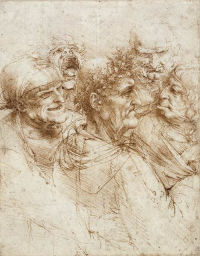Imagination and Invention Click on the thumbnails to explore the trail
Read more about this trail (expand)
The exercise of imaginative fantasy was as much an integral part of Leonardo’s mind as the discipline of scientific observation. For the artist, imagination was dependent upon an accurate understanding of observational input – a complete comprehension of the geometry of God’s design. Sensory impressions gained from observation were recombined by the artist’s ‘fantasia’ or imagination, to create new and credible forms

- Enlarge
- Zoom & explore
- The Royal Collection © 2005, Her Majesty Queen Elizabeth II
Study of five characters c1494
Leonardo had a good sense of humour. His love of crude jokes and satirical tales of human weaknesses was very much in keeping with the courtly tastes of his time. No doubt it increased his popularity amongst patrons and courtiers alike.
Leonardo seems to have developed an interest in bizarre figure types during his youth while training in the workshop of Verrocchio in Florence. Drawings such as this are best considered as visual equivalents to contemporary literature rather than illustrations of a particular story or tale. They were probably inspired by Italian novelle, which were literary tales of a scurrilous nature involving lunatics, idiots, or any other characters easily held in derision.
This drawing is the most elaborate and spectacular of Leonardo’s character drawings. The figures are extremely exaggerated, even verging on the grotesque, and can be seen as early forerunners to the caricature. However, there seems to be a note of compassion in the gentle dignity of the old man seen in profile in the centre of the composition, and in the serious gaze of the male figure behind on the right.
In Leonardo's words
Leonardo once wished to make a picture of some laughing peasants. He picked out certain men… and arranged a feast for them…and sitting close to them he proceeded to tell the maddest and most ridiculous tales imaginable, making them, who were unaware of his intentions, laugh uproariously. Whereupon he observed all their gestures very attentively and those ridiculous things they were doing, and impressed them on his mind, and, after they had left, he retired to his room and there made a perfect drawing which moved those who looked at it to laughter as if they had been moved by Leonardo’s stories at the feast.
This drawing is often described as the finest of Leonardo’s caricature drawings, but strictly speaking, not all of the figures can be classed as caricatures.
The compositional arrangement is also not typical of Leonardo’s caricature drawings. In the centre is a bald old man of the classical type seen in profile crowned with a wreath of laurel leaves. He is surrounded by various figures, all of a particularised type. To the left, an elderly, grinning woman with a huge chin is shown putting her right arm around the central figure.
On the right, a figure with long wavy hair, a huge under-lip and receding chin looks to the left. Behind on the left a figure throws its head back, its open mouth suggests that it is yelling, while to the right an old man is shown almost full-face with a placid expression.
The meaning of the drawing is difficult to detect. The figures are unlikely to represent the “four temperaments” as was once proposed, not least of all because there are five. They do however correspond to Leonardo’s advice about mixing the “conditions of man” in close proximity for effect.
The drawing may also relate to the tradition of burlesque poetry, as practised at the Milanese court. Ironic poems that mocked the ugly and idiotic through a knowing distortion of sophisticated love poetry were a favourite form of courtly entertainment. It is possible that Leonardo’s drawing has a similar humorous or ironic intent.
A narrative interpretation has also been suggested whereby the central “crowned” character is being encouraged by his accomplices to parade himself as something he is not, as a sort of “king of fools”.
Three of the figures appear in a Flemish painting of a mock marriage that may imitate a work by the artist Quinten Massys who worked in Antwerp during the early 16th century, and who produced numerous paintings based on Leonardo’s drawings.
- Medium Pen and ink on paper
- Size 26 x 20.5 cm
- Location The Royal Collection










